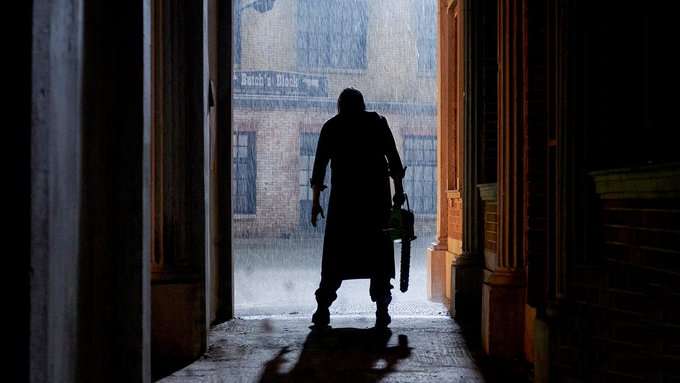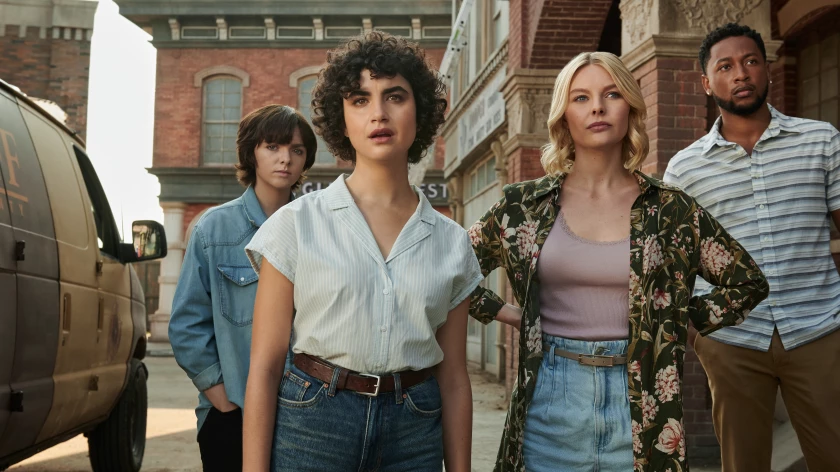
Texas Chainsaw Massacre Review: This movie was released on Netflix on February 18, 2022. Critics largely gave the picture a bad review. Let’s see what went wrong…
Directed by: David Blue Garcia
Screenplay by: Chris Thomas Devlin
Story by: Fede Álvarez, Rodo Sayagues
Based on: Characters by Kim Henkel, Tobe Hooper
Produced by: Fede Álvarez, Rodo Sayagues
Starring: Sarah Yarkin, Elsie Fisher, Mark Burnham, Jacob Latimore, Moe Dunford, Olwen Fouéré, Alice Krige, Jessica Allain, Nell Hudson
Edited by: Christopher S. Capp
Music by: Colin Stetson
Production companies: Legendary Pictures, Bad Hombre, Exurbia Films
Texas Chainsaw Massacre Review
“Texas Chainsaw Massacre” seeks to revive a horror legend, following in the footsteps of previous reboots “Halloween” and “Scream.” Sally Hardesty may not have had the same cultural awareness as Laurie Strode or Sidney Prescott, but she is the original “last girl” and deserves appreciation. Unfortunately, this direct sequel to 1974’s “The Texas Chain Saw Massacre” does not provide the triumphant comeback that the scream queen, played by Olwen Fouéré, deserves.
Sally isn’t the only one who gets short shrift: “Texas Chainsaw Massacre,” directed by David Blue Garcia, flirts with social commentary on school shootings, gentrification, and racism. However, it’s not quite as effective as Leatherface (Mark Burnham) smashing someone’s head with a mallet.
The original’s persistent country-versus-city theme returns, but this time it’s not hippies who travel into rural land with fatal consequences. Sarah Yarkin, Jacob Latimore, Elsie Fisher, and Nell Hudson, all from Austin, see opportunity in a Texas ghost town, but their presence displaces a longstanding resident (Alice Krige) and the enormous, troubled man in her care (guess who).
The film’s first kill sets a bar that the rest of the film can’t match in the hundreds of deaths that follow. Leatherface’s unrelenting carnage is both excessive and insufficient, with each subsequent murder evoking less of a response. Is there any more blood? Shrug.
This can’t be a good feeling, yet “Texas Chainsaw Massacre” never inspires the dread that defined the original, opting instead for revulsion at the profusion of viscera. The 1974 picture was a nightmare that came dangerously close to reality, but this is just as bad.
Also read,
Is Texas Chainsaw Massacre worth watching?
For anybody interested in horror films, the original Texas Chainsaw Massacre is must watching. However, there are two issues that may need to be addressed.
To begin with, the original film isn’t particularly graphic. There isn’t much blood. Because of the notions, it sets in your brain, the film is extremely upsetting. It imposes gore suggestions rather than gore visuals on you. As a result, it’s a lot more disturbing.
Second, it isn’t exactly enjoyable. It’s gloomy and unsettling. Even when it’s humorous, the characters are driven by dark, twisted humor. It’s a narrative built on circumstances and characters, and none of it is really light. To be honest, we horror fans find such things amusing, but Texas Chainsaw is not a good narrative.
The remainder of the films in the series is a waste of time. They’re considerably gorier and funnier than the original – as in, laugh-out-loud funny. The remake falls short of the original in terms of visual appeal and fails to capture the subtleties that made the original so memorable. As a result, ranking them is simple. The original is the finest, and one of the greatest horror films ever made, while the others are simply a hot heap of rubbish.
Is the Texas Chainsaw Massacre a true story?
Tobe Hooper, co-writer and director of the 1974 movie, has spoken about three occurrences that inspired the concept and script he and Kim Henkel eventually wrote.
Thread one
Tobe Hooper had a family who resided in Wisconsin, which also happened to be where Ed Gein lived (Plainfield). These Wisconsin relatives informed a young Tobe about Ed Gein’s actions in his infamous farmhouse, the image of furniture and home goods made of bones and human skin, as well as Gein murdering and hanging a woman’s body at the smokehouse, stayed in Hooper’s mind.
Thread two
The second narrative thread is as follows: Tobe Hooper heard a tale from a medical student at the University of Texas, either as a student or while teaching documentary cinema there, about a medical student who took the skin from a cadaver’s face and wore it as a mask to a Halloween party. Hooper didn’t say what the other guests at the Halloween party thought of the outfit, but I’m sure it was met with shock and amazement. While Hooper may have heard this from a real medical student, it should be noted that there are also urban tales about medical students and cadaver skin that circulate in our culture. My parents both informed me that they first heard about this story in graduate school in the 1970s. It’s conceivable that Hooper heard the urban legend from a medical student because the University of Texas has a medical school, or it’s likely that Hooper had heard the urban tale before and the two merely merged in his memory.
Thread three
Tobe Hooper was in line at a Sears shop; he doesn’t say which one or what year it was, but because Sears is a department store, you can be standing in the clothing area and see the hardware department and all of the equipment for sale. The distance between one half and the other is only a short distance. While waiting in line, Hooper notices a chainsaw for sale and considers how to reduce the number of people waiting to pay for their purchases.
These were the strands that Henkel and Hooper intertwined to weave the film’s plot. The core idea is a well-worn horror trope: a group of friends encounters a bunch of strangers by chance, with terrible consequences.
I believe that the anxiety of confronting danger and uncertainty in what should be familiar is what makes the first Chainsaw film so fantastic. When there are pieces of furniture built from bones within the home, the chicken in the cage, and the understanding that not everything is right, the familiarity of a country house is entirely turned inside out. That’s both terrifying and effective, yet the sequels to Chainsaw failed to capture these characteristics well.
That is all about Texas Chainsaw Massacre Review. Get in touch…
Also read,
Get the latest movie reviews on Medico topics and its Twitter page.
I’m Nawin (Admin), a seasoned doctor and accomplished content writer with 8 years of experience. Join me as I unravel the latest breaking news, unveil behind-the-scenes happenings, and explore the aftermath scenes. With my expertise, I’ve crafted this renowned news site to provide you with an authentic perspective on daily happenings. Get ready to delve into a world of truth and knowledge on Medico Topics.
Coverage: Blogs, Health, Exams, Obituary, Crime


1 thought on “Texas Chainsaw Massacre Review: Is This Texas Chainsaw Massacre worth watching?”